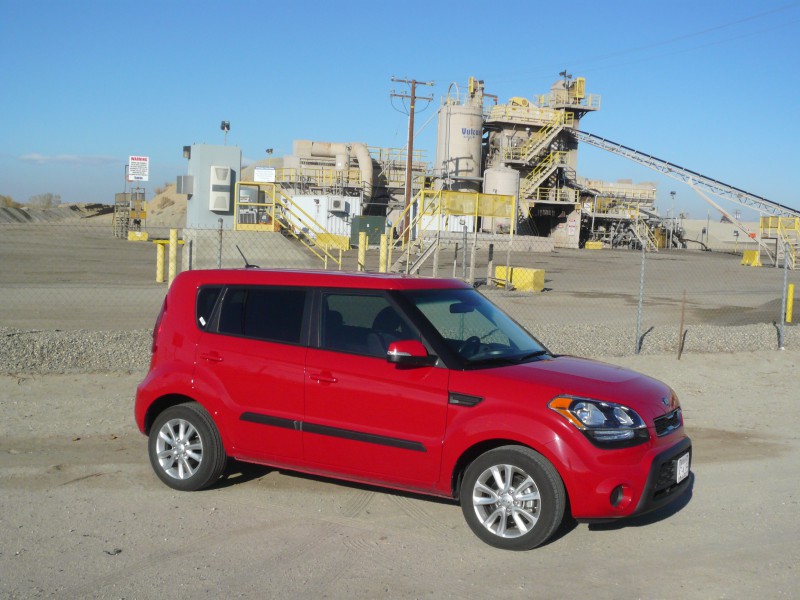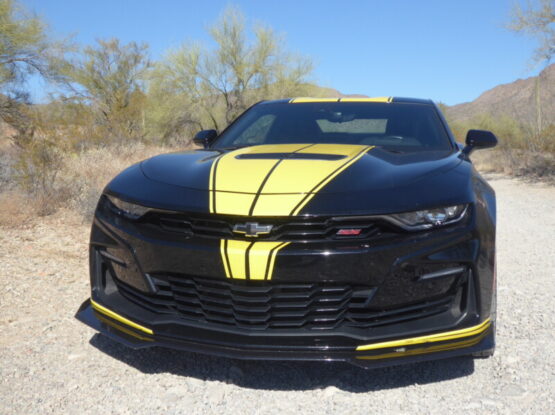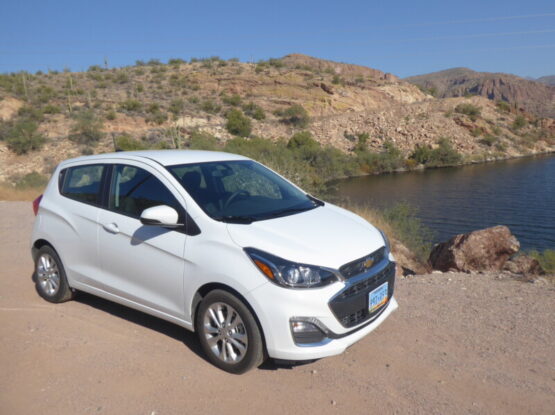


























In Europe, the Soul is sold with a choice of either a 1.6 litre petrol or diesel engine, and opinions have always varied as to which would be the one to select. In America, though, there is no sign of a diesel model, but as well as the entry level petrol, there is a more potent 2 litre engine offered as well. Unlike the smaller powerplant which is still coupled with a four speed automatic transmission, the 2 litre unit comes with 6 gears in the self shifter, so in the absence of any distinguishing badges or even labels on the car, all I had to do was to count the gears to find out what was under the bonnet of the test car. It turned out to be the larger engine. It generates 164 bhp, which ought to make a car of the Soul’s size, its rather bluff shape notwithstanding, decently quick. It does not, but nor is it slow. In ordinary urban driving, all appears well, and the Kia comes across as quite peppy, but at times when a sudden burst of acceleration is needed, or when going up hills, you will have to work it quite hard. And when accelerating hard, the Soul can get quite noisy, but at a steady speed, such as when cruising on the freeway, it proved pleasingly quiet and refined. The six speed automatic does operate very smoothly, but I found that it sometimes had a tendency to hang onto a higher gear, no doubt in the interests of economy, but this did mean that you needed to be that bit more brutal to get the necessary acceleration. With more torque, you might get away with it, but in this application, you don’t. In any case, the Soul did turn in decent levels of economy, averaging 31 mpg US over the 310 mile test drive. That’s 37 mpg Imperial. And that was without using the “ECO” setting that I found, which is selected by pressing a large green button on the dash to the left of the steering wheel. There is some body roll evident on the corners and the Kia does understeer a bit. Nonetheless, I took it up on the swopping canyon roads north of LA, and it was surprisingly good fun to hustle along them, with apposite weighting to the steering. There were no issues with the brakes, which did their job, and got an early test when a liveried S Class Mercedes pulled out in front of me with no warning. A central pull up handbrake is fitted between the seats. The Soul is easy to manoeuvre, as not only is it relatively small, but the upright design at the back means that judging where it ends is easy, and there are both good amounts of glass and a decent field of view from the mirrors, though rear three-quarter vision is a little limited thanks to the upswept third windows.
The interior design of the test car looked very similar to that which I had experienced, albeit in right hand drive form, once before, but as part of the refresh program applied to the Soul, whilst the design was retained, a significant improvement in material quality came about, and there are some detailed differences. The dash is dominated by the central section which juts out and is slanted at roughly a 60 degree angle, astride the central air vents, and containing controls for the audio unit and air conditioning, but slightly surprisingly, not the gearlever, which is in a conventional place in the centre console between the seats.. To the left of this raised area are the three instruments, with central speedometer flanked by a rev counter to the left and a combined dial for fuel level and water temperature to the right, each in a heavily cowled dial of its own, under a single binnacle. Twin column stalks operate the indicators and lights from the left hand talk and wipers from the right, and that is more or less it. There are audio unit repeaters and buttons of the cruise control to be found on the boss of the nicely leather wrapped steering wheel. It is all very clear and easy to use, and following the upgrade to the quality and texture of the plastics used, appropriate for a practical car like the Soul.
As with most test cars, when I got in, I set the seat as low as it would go, and then the wheel as high as it would go, as my starting attempt at the optimum driving position. It turned out that this was indeed the best fit for my proportions, but you will notice that you still appear to be sitting relatively high and the wheel is perhaps a touch lower than you would like. Thanks to the shape of the Soul, though, your head is a long way from the roof. Once acclimatised to this set up, I actually found it neither to generate issues, and indeed to give you a very slight SUV sensation of sitting above other road users, even though in reality, you are not. Adjustment for the seat is all manual, with a ratchet style lever on the side of the seat for both backrest angle and seat height.
When the Soul was first launched, Kia made much of the style, and tried to create an image with a number of limited edition models and some slightly wacky trim and logo ideas. I cannot recall ever seeing any of these cars actually on the road, but there are still reminders of what they were trying to do with the Soul logo that is featured extensively on the seat trim and the door casings. Although I would normally hate such a thing, it seems quite fitting for the style of the vehicle. The seats themselves are trimmed in a sort of hard wearing cloth, and were predominantly black. Despite this, because of the high roof and decent glass area, the interior of the Soul is not as funereal as you might expect.
Box like cars such as the Soul are expected to score heavily for practicality, and the Soul acquits itself well. Within its compact dimensions, there are almost tardis like levels of space, created largely because the extra height of the design is used to good advantage in seating people so as to take maximum advantage. There are good levels of leg room for those in the rear seats, and the occupants would need to be very tall indeed to get close to the rear headlining. Three will fit across the rear seat, though as this is not a particularly wide car, their shoulders would get a bit intimate. With the seats erect, there is boot space with a relatively modest floor area, but it is quite deep, especially if you take out the false floor. Leaving this in situ gives an area to hide smaller valuables under the boot, and there is a bit of space under this around the spare wheel for odds and ends. The luggage area is extended by simply dropping the asymmetrically split rear seat backrests forward, where they rest on the seat cushions, and slope up very slightly. Inside the cabin, there is a huge split-level glove box, a lidded compartment on the top of the dash above the audio unit, a cubby under the central armrest, a good sized space in front of the gearlever, and door bins on all doors.
European models of the Soul are denoted by numeric trim identifiers, 1, 2 and 3, but in the US, the nomenclature is Base, + (Plus) and ! (Exclaim). The test car was a +. Base models have the 1.6 litre engine, whereas the + and the ! have the 2 litre. Even the Base cars have cruise control and a decent audio unit with AM/FM and XM Satellite radio, as well as an AUX and MP3 port, CD and a cassette player, this last feature does not appear in the more costly models, and have been widely praised for not feeling like a stripped out economy special. As well as the larger engine, the + brings along that nice leather wrapped steering wheel and heated door mirrors. Additions in the ! include front fog lights, a power sunroof, a back-up camera, auto sensing headlights, and a premium sound system. Needless to say, there are plenty of personalisation options available, ranging from body decals to different wheels as well as the usual comfort and convenience features which many like to add (and pay for).
This test did nothing to suggest that the Soul is mis-placed on my “guilty pleasures” list. Accept the Kia for what it is, a small and affordable practical car with a dose of funky style added to the mix, and it scores pretty highly, so it is no surprise that especially when you factor in the good reliability and in the US, a 10 year warranty, to find out that it has outsold rivals by such a strong margin. But then, I discovered something quite surprising. Although the target market may initially have been the youth: the college kids, or those who wanted a small practical car and who did not care for the little Scions, the Nissan Cube and the now discontinued Honda Element, the reality is that a majority of Soul buyers are male, and their average age is, well, let’s put it like this, very close to mine. So, perhaps it is no surprise that I liked the Soul, as so, it would seem, do plenty of my peers. Kia have just released a second generation model, and recognising that they would be ill-advised to mess with what has been a huge sales success for them, it does not mess much with the styling (though I think I prefer the version I tested), but it does have a higher quality interior and the chassis has been reworked, now based on the latest Cee’d. I am told by those who have already driven it, that it is a “far better car”, so I look forward to sampling one to see for myself.













































